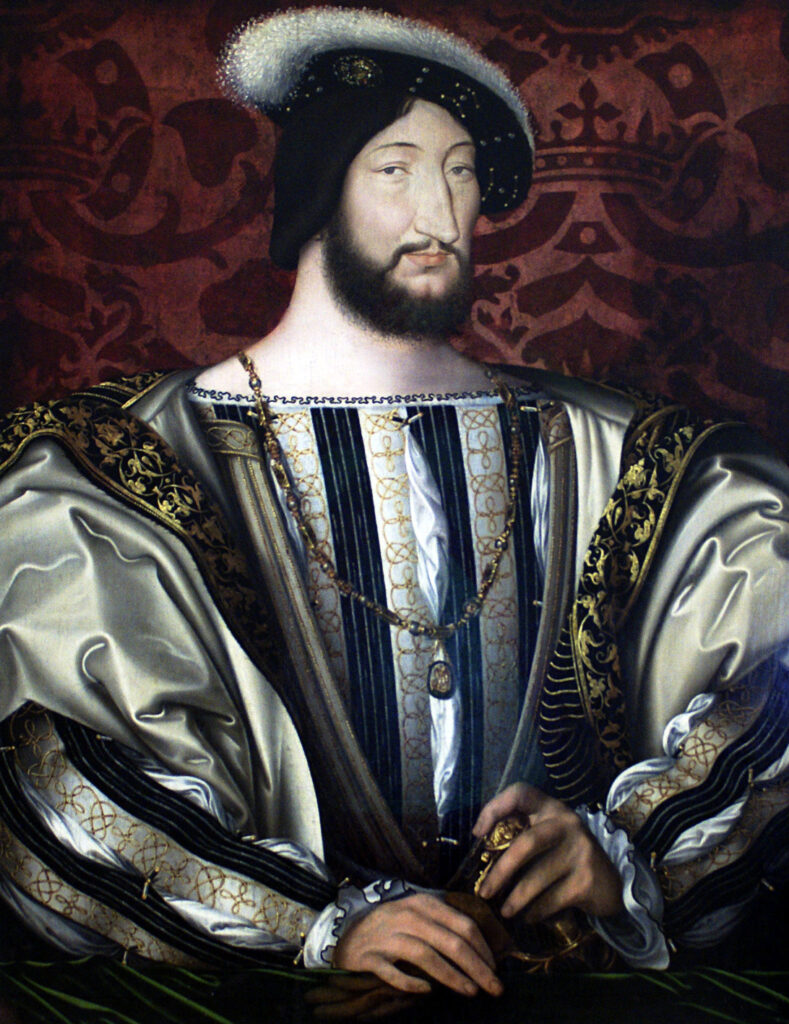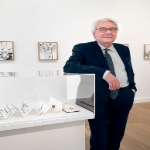TRANSLATED FROM THE FRENCH BY JOHN TAYLOR
TEMPTING FATE
– Jean Frémon
Translated from the French by John Taylor
Francis the first of the Valois, cherished a dream. Some might have said that it was an insane ambition: recovering Charlemagne’s empire for his French lineage. Actually, it was an old French dream. Several kings, including Phillip the Fair and Saint Louis, had done more than merely muse about it, but none had directly sought to win the election, and the crown had remained German. The Habsburg Empire extended from Pomerania in the north to Tuscany in the south, from Burgundy in the west to Moravia in the east. In Italy, the popes, one after the other, kindled hostility between the Guelphs and the Ghibellines.
He was born Francis of Angoulême, the son of Charles, prince of the blood. Not being the king’s son, his chances of becoming one were slight. But this was without counting on chance, “God’s straw man,” as Marguerite Yourcenar put it.
After twenty-two years of marriage, Joan of France and Louis XII still had no descendants. The interests of the realm implied that Louis must wed Anne of Brittany, who was the widow of Charles VIII. The marriage with Joan was nullified by the pope.
With Anne, Louis had two daughters, Claude and Renée, and three sons who lived only a few days. With each birth and each death, Francis’s destiny changed directions. When he marries Claude, he comes still closer to the throne. He does not possess the title of dauphin, but everyone now perceives him as such. His height and imposing presence speak for him; he already inhabits the role. He can now dream of a destiny.
On the first day of the year 1515, Louis XII, barely three months after the celebration of his third marriage, with Mary Tudor, and after reigning for sixteen years, gave up the ghost. Francis was twenty years old.
Jean Clouet shows him to us: small narrow eyes, a gaze that is benevolent (or perhaps cunning), a slender black moustache joining a chinstrap beard of which it was said that it was designed to conceal a scar and which became so fashionable that all the courtiers, scarred or not, promptly adopted it; and that nose, a very long slender yet robust nose whose point almost reaches the upper lip, letting one imagine its equivalent in cockiness beneath the gold and velvet of his breeches. Francis had everything that it takes to be a king, so why not ask for more? Didn’t he already demand that others call him His Majesty, a title until then reserved for emperors?
In freezing weather, on 25 January, he walks under the cathedral porch in Reims, where the angel’s smile greets him. Kneeling in the chancel, in an ermine-lined velvet coat, he receives the scepter, the brooch, the hand of justice inherited from Saint Louis, as well as Charlemagne’s legendary sword, the so-called Joyeuse. He thus takes possession of the symbols of a power whose reality still escapes him. This power lies in the hands of Maximilian, who intends to hand it over to none other than Charles, his grandson.
This is the nineteen-year-old Charles of Gand, who is soon to become King of Spain and Naples. In his role as Duke of Burgundy and Count of Flanders, he was required to attend the crowning of the King of France. He finds an excuse for not being there.
Francis resolved to seize the Holy Roman Empire without waging battle. This was not because the king feared war. At the head of his troops, he had put to rout the Swiss soldiery and driven Sforza out of Milan. But acquiring the Holy Roman Empire was a political affair, not one of war. It was a matter of winning over the votes of the Prince-Electors: three archbishops and four German princes.
Maximilian was old and ailing as the election inexorably approached. Francis sent confidence men entrusted with distributing generous prebends and advice. It was time, they said, that the Holy Roman Empire crown returned to the eldest son of the church. He alone would know how to unite all the Christian princes under his banner to vanquish the Turks, who were at the gates of Vienna. Selim had just entered Jerusalem and Cairo.
Pope Leo X, who was the Emperor’s eternal rival, looked favorably on the French King’s ambition. Leo possessed an additional argument to counter Charles: aKing of Naples could not also be King of the Romans. By accepting the first title, Charles renounced the second one in advance.
Giovanni, who was Lorenzo de’ Medici’s son, had spent his childhood among artists. In Florence, Michelangelo occupied apartments next to his own. Once he had been elected pope, Giovanni, now rechristened Leo X, confirmed the commissions given to Raphael by Julius II. In order to let the King of France know of his preferences, Leo X sent to him several paintings by the master artist of Urbino: the imposing Saint Michael Slaying the Dragon and the Holy Family, both housed today in the Louvre, are gifts from the pope.
When Leo X entered the Vatican, he discovered Raphael working on Heliodorus’s room. He was painting the meeting between Attila and Pope Leo I. The leader of the Huns astride his black steed, at the head of a furious horde emerging from a town in flames, watches a serene, impassive pope on a white horse riding up to him. Leo X ordered Raphael to paint this pope’s face to resemble his own. For the next room, he orders the artist to illustrate the achievements of the preceding popes who had chosen the name of Leo and also to paint them with his own features. Leo X can thus be seen incarnating his fourth predecessor who stops the great fire of Borgo by making a miraculous sign of the cross. The next scene presents Leo X in the role of Leo III celebrating Charlemagne’s coronation at Saint Peter’s Basilica in Rome.
Do we know what Charlemagne looked like? A few unearthed medals show a beardless profile and a laurel-crowned forehead as is appropriate for a Roman emperor. Later, legend made his beard flourish. What could young Raphael know? And what he knew did not matter. Back then, the great of this world were depicted more by their attributes and by conforming to a tradition than by an alleged resemblance which, in all events, would have been imaginary.
But what can be seen on the Vatican fresco? How surprising! He who holds the crown, Léo III, has the roundish feminine features of Leo X. As we have understood, this results from the narcissistic caprice of the new pope, who claims to reincarnate his predecessors. However, doesn’t the man kneeling in front of him, Charlemagne, who is depicted from behind yet whose profile nonetheless stands out, clearly have Francis I’s incomparable nose? It is the same nose later immortalized by Titian who, inspired by a medal because he lacked the living model, painted the king in profile: the same majestic nose, placed like a postiche on the kneeling emperor’s face, by itself signifies Francis and Leo’s ambition.
How bold, one will say, to paint the founder of the Holy Roman Empire of the German Nation with the features of the King of France who is competing to succeed to the throne! Were Francis and Leo so confident in the success of their endeavor that they allowed themselves to bear witness to it, by means of an image, before it even happened? By giving Charlemagne Francis’s face, Raphael ran the risk of finding himself disavowed by History. Perhaps he cared little about this, since he was concerned only about painting. . .
However, a little later, the archbishops of Mainz, Cologne, and Trier, the King of Bohemia, the Duke of Saxony, the Count Palatine of the Rhine, and the Margrave of Brandenburg, all of whom, in exchange for promises, had received largesse from Francis I, unanimously voted for Charles V. The Empire was German and would remain so. Realistic or resigned, Leo X joined their cause. Francis I’s dream was shattered. A King of Naples will also be King of the Romans. France is now outflanked on the north, the east, and the south. And soon Francis, after the disaster of Pavia, will find himself in Madrid, imprisoned by Charles. Aretino, a master at flattering, can indeed write that victories are the ruin of the winner and the salvation of the loser; for the victors, blinded by the insolence of pride, forget God and dream only of themselves, whereas the losers, enlightened by the modesty of humility, forget themselves in order to think only of God. A paltry consolation.
Carried away by zeal (or duly egged on by Leo), Raphael ended up painting an event, from History, that did not take place. Even if only allusively, the act of painting History as one wishes it to be, not as it actually turns out to be, is not without risks. Leo X had to accommodate himself with the Ghibelline party, and Francis, who was not lacking vainglory (he would sign his edits “For such is my pleasure”), had to content himself with more banal pleasures.
François Clouet, the son of Jean (who was nicknamed Janet), made a sanguine sketch of the aged king’s face. With respect to all the other portraits at the time, this one is a face view, without the bust; the head is uncovered and takes up the entire sheet of paper. Francis’s hair has thinned out and is pushed back towards the front as if to conceal a receding hairline. The beard is longer and thicker. The dark circles under his eyes indicate the weariness of this fifty-two-year-old giant. It is not a flattering portrait, but instead a kind of documentary assessment that will prove to be useful.
In February 1547, the king, hunting near Rochefort, was taken with fever. His doctors ordered him to return forthwith to Saint Germain. Too feeble for this long journey, the king and his suite made a halt at the abode of Jacques d’Angennes, his Captain of the Guards and the lord of Rambouillet. Rambouillet Castle was the final resting place of the king. On 31 March, after receiving the dauphin’s visit, Francis I passed away.
François Clouet was summoned to Rambouillet to make the death mask. From the plaster cast, he fashioned a wax effigy that he continued to perfect in accordance with his sanguine sketch, to make the effigy appear to be alive. This wax face was then placed on the body of a mannequin built with rags and woven osier. The mannequin had exactly the same size as the deceased king. It was richly dressed. Linen socks were pulled up its stiff legs and cloth-of-gold, satin-soled ankle boots were placed on its osier feet. The mannequin’s arms were slipped into the sleeves of a satin vest and a tunic speckled with gold lilies. The body was then covered with a long ermine-collared coat. The osier hands, clasped on the bust, wore white gloves. A velvet bonnet beneath the crown covered the head.
François Clouet busied himself for three weeks fabricating the king’s second body. When the effigy was ready, it was transported to Saint Cloud, where the casket was already waiting. The effigy was placed in the room next to the richly decorated mortuary chamber with its rugs, wall drapes, and velvet canopy suspended from the ceiling.
For the entire month of April, tributes were paid to the osier mannequin as if it were the living king. All the while, in the next room, the corpse in its leaden casket awaited its burial.
For eleven days, the three meal services were mimicked in front of the king’s effigy. The members of the royal family and the various dignitaries came to mourn in the chamber of honor. Everyone, that is, except the new king, Henry II. Henry II entered the chamber only forty-eight days after his father’s death. Two kings of France must not be in the same room. As long as the effigy was exhibited, the fiction was maintained that Francis was still king. Henry II’s entrance into the chamber therefore put an end to the private ceremonies, and the public funeral could now take place in the Notre-Dame-des-Champs Church.
In the meantime, Henry II had commissioned from Philibert Delorme a marble gisant in the king’s effigy for the tomb in the Basilica of Saint-Denis. Delorme could not complete it. It was his student, Pierre Bontemps, who finished it almost ten years later. The king is naked, emaciated almost as much as a transi cadaver monument, his head turned to the side, his hands hiding his genitals. An effigy far removed from the rich apparel with which the osier mannequin was dressed and which gave him, for a few weeks, a supplement of fictive life.
The images of King Francis, as painted by Jean Clouet and his son François, or by Titian at Aretino’s request, remain prominently displayed in the Louvre. Raphael’s painting of him in Charlemagne’s costume is still visible on the walls of the Vatican. The naked gisantcarved in marble by Bontemps still lies in the transept of Saint-Denis. But what happened to the wax-and-osier mannequin that had been regally dressed and fashioned so carefully by François Clouet? Was it entitled to a peaceful retirement as a royal scarecrow in one of the wheatfields of the realm? It is more likely that it was simply left to rot in the ditches of Rambouillet or that, once the festivities were over, it was burned with other garbage at the edge of town.
Francis would enjoy still another posthumous life in painting. He liked poets and painters. This guild was not ungrateful to him. Two centuries later, the Restauration, concerned about improving its image, made him the herald of an enlightened monarchy that is a patron of the arts. Francis, whom historians had until then described as a rather vain hunk whom reality had humiliated, suddenly becomes the symbol of the Renaissance. His relationship with Leonardo is blown out of proportion. The Clos Lucé, near Amboise, is a charming place to sojourn. It is within its rose-brick walls that the king invites the painter to take up residence. It was rumored that there was a secret passageway connecting the castle to the Clos Lucé, enabling the monarch to visit his great friend at leisure. Is it on unverified factual grounds that Vasari asserts that the king unexpectedly arrived in the master artist’s bedroom when he was dying? As if he had been an eyewitness, the chronicler writes that the king held up Leonardo’s head to help him breathe and that the painter passed away in his august arms.
Two centuries later, François Guillaume Ménageot, who had won the Prix de Rome, exhibited his The Death of Leonardo da Vinchi in the Arms of Francis I in the Salon. At the dying man’s bedside, the king is holding up Leonardo by the armpits to help him to sit up. The clouded gaze of the white-bearded master artist loses itself in the compassionate sovereign’s eyes. On the other side of the bed, a doctor is taking the dying man’s pulse and, with his other hand, making a sign to the servant woman, who is bringing a potion, that there is no longer time. Two richly dressed young children are present at the scene: probably the dauphin and one of his playmates. Idealized images are made for history textbooks: the two children represent the youth of France who must be brought up properly. (It is unimportant that the future Henry II, in May 1519, when Leonardo died, was still in swaddling clothes.)
Ingres took up the same scene with the mastery for which he was known. This time, the king is in the center of the painting, framed by the curtains of the baldachin. He has left his armchair, which had been pushed forward for him, to sit on the bed of the artist, whom he envelops with his arms. The profile of the long-nosed king with his sumptuous costume have mostly been copied from the painting made by Titian, who had never seen his model. The scene has an explicit moral: it is the whole spirit of the Renaissance that Leonard, on his deathbed, hands over to Francis I so that it will be in his care. The entire monarchy is now the depository.
On 2 May 1519, as is revealed by archives, the king was in Saint-Germain-en-Laye and not at Amboise nor at the Clos Lucé. Does painting history amount to accrediting a legend? The scene described by Vasari in 1550 is a fable. It was taken up by Ménageot in 1781, then in 1818 by Ingres who, after immortalizing Napoleon as a Roman emperor, valiantly put himself in the service of the new national novel.
Also, read Sita Of Bandhavgarh, written by Indira Dangi, translated from the Hindi by Anuradha Dosad and published in The Antonym.
| SITA OF BANDHAVGARH — INDIRA DANGI
Follow The Antonym’s Facebook page and Instagram account for more content and interesting updates.




























0 Comments